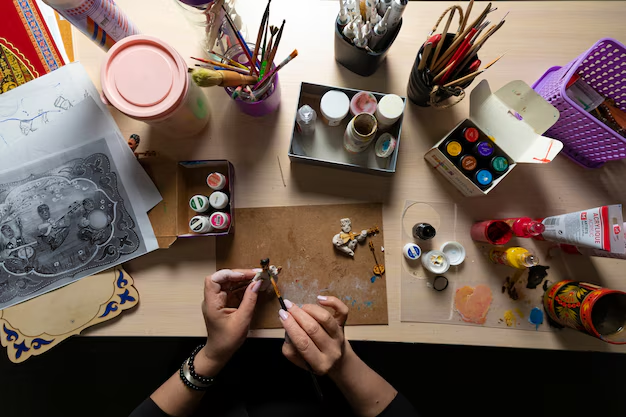Arts & Crafts for All Ages: Fostering Creativity and Skill
Arts & Crafts for All Ages: Fostering Creativity and Skill” is an inspiring topic that highlights the universal benefits of creative expression and hands-on learning. Arts and crafts are powerful tools for building creativity, problem-solving, and fine motor skills. They can also promote emotional well-being and social connections. Here are some key themes and approaches to explore within this topic:
1. Creativity Across the Lifespan
- Benefits for Children: Engaging in arts and crafts at an early age helps children develop essential cognitive skills like critical thinking, focus, and problem-solving. It also supports fine motor development and spatial awareness.
- Adult Creativity: For adults, arts and crafts can be a way to express emotions, reduce stress, and improve cognitive function. Creative activities provide a sense of accomplishment and can be a meaningful way to spend time.
- Senior Engagement: For older adults, crafting can promote mental health, memory retention, and dexterity. Activities like knitting, painting, and sculpting have been shown to reduce the risk of cognitive decline and improve overall well-being.
2. Inclusive and Adaptive Arts & Crafts
- Accessibility for All: Arts and crafts activities can be adapted to meet the needs of people with various physical and cognitive abilities. For example, using tools that are easier to grip or employing different textures can make crafts more accessible for individuals with disabilities.
- Multicultural Crafts: Exploring diverse cultural crafts can expand participants’ worldviews while fostering an appreciation for different traditions and histories. Projects like Mexican papel picado, Japanese origami, or African beadwork allow for meaningful cultural exchange and learning.
3. Building Fine Motor Skills and Hand-Eye Coordination
- Hands-On Learning: Activities such as sewing, knitting, painting, sculpting, or woodworking help refine motor skills. These crafts require careful control of small movements and attention to detail, benefiting children and adults alike.
- Therapeutic Benefits: Arts and crafts can serve as therapeutic activities for improving dexterity and coordination, especially for those recovering from injuries or surgeries.
4. Expressing Emotions and Building Confidence
- Art as a Form of Communication: For people of all ages, art provides an outlet for expressing feelings and experiences that might be difficult to verbalize. This is especially helpful for children or individuals going through challenging times.
- Boosting Self-Esteem: Completing a craft project can be empowering and provide a sense of accomplishment. The positive reinforcement gained from creating something tangible can enhance confidence and self-worth.
5. Sustainability and Eco-Friendly Crafts
- Upcycled Art: Teaching children and adults how to use everyday items like old newspapers, cardboard, or fabric scraps to create beautiful crafts not only sparks creativity but also promotes sustainability.
- Eco-Conscious Materials: Using natural, recyclable, or biodegradable materials in arts and crafts projects fosters environmental responsibility. It also allows for discussions on sustainability and caring for the planet.
6. Family and Social Bonding
- Collaborative Projects: Arts and crafts provide an opportunity for families or friends to work together. Crafting can encourage teamwork, patience, and communication, whether making holiday decorations or creating a mural as a group project.
- Social Connection: Crafting in group settings (e.g., workshops, clubs, or community centers) can help reduce isolation and encourage socializing, especially for those who may have limited interaction with others, such as seniors or people with disabilities.
7. Exploring Different Mediums
- Painting and Drawing: Simple yet effective ways to encourage creativity. Painting with watercolors, oils, or acrylics, or drawing with pencils or charcoal, can teach color theory, shapes, and perspective.
- Clay and Sculpture: Working with clay or other sculpting materials like plaster or wood fosters a hands-on understanding of 3D space and shapes.
- Textiles: Sewing, knitting, and crochet are wonderful ways to practice patience, precision, and craftsmanship while creating functional items like clothing or home décor.
- Paper Crafts: From origami to scrapbooking, working with paper offers endless opportunities for creativity and exploration, often requiring no special tools or materials.
8. Mindfulness and Relaxation Through Crafts
- Therapeutic Crafting: Activities such as coloring, knitting, or painting can be deeply relaxing and meditative. The repetitive motions of certain crafts help calm the mind and reduce anxiety, making them excellent mindfulness practices.
- Stress Relief: Engaging in a creative activity can help lower stress levels by providing a distraction from worries and focusing the mind on the task at hand.
9. Crafting for Learning and Education
- STEM and Craft: Integrating arts and crafts with STEM education (Science, Technology, Engineering, and Mathematics) can create engaging learning experiences for students of all ages. For example, building simple machines or experimenting with different materials can lead to discussions about engineering concepts and creativity.
- Literacy and Numeracy: Arts and crafts can also support literacy and numeracy development, like writing stories, designing posters, or creating projects that incorporate mathematical concepts.
10. Virtual Craft Communities
- Online Crafting Groups: The rise of social media and digital platforms has created virtual crafting communities, where people of all ages can share ideas, tips, and finished projects. Virtual workshops and tutorials make it easier than ever to learn new crafts from anywhere in the world.
11. Intergenerational Crafting
- Bridging Generations: Crafting is a great way for different generations to connect. Grandparents, parents, and children can work together on projects, sharing knowledge, techniques, and stories that promote intergenerational bonding.
12. Celebrating Craftsmanship and Cultural Traditions
- Honoring Craftsmanship: In a world of mass production, engaging with traditional handcrafts celebrates the value of slow, deliberate work. Techniques such as woodworking, weaving, and pottery connect participants with centuries-old traditions and allow for deep skill-building.
Arts and crafts are not only enjoyable and rewarding activities; they are also essential for developing key life skills, fostering emotional well-being, and creating a sense of community. Whether for children, adults, or seniors, these activities offer endless opportunities to unlock creativity, build skills, and have fun.
Are there any specific types of crafts or age groups you’d like to focus on in this conversation?

